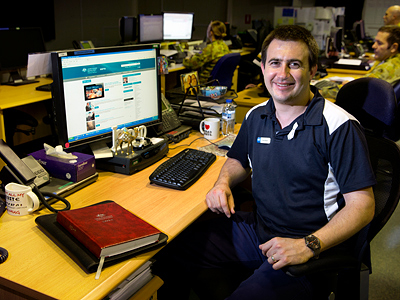Scientists also serve on the frontline

An Anzac Day feature - DST Group shines the light on the important role Defence Scientists can have on the frontline.
Over the last decade more than 200 Defence scientists have been deployed to support Australian military operations, contributing to the protection of Australian men and women serving overseas.
The support provided by these scientists has enhanced the operational capability and effectiveness of the Australian Defence Force (ADF) in a number of locations across the Middle East, in Timor-Leste, the Solomon Islands and Papua New Guinea. There have also been deployments in support of ADF humanitarian aid and disaster relief operations to Indonesia, Pakistan and Fiji.
Defence employee Allan Cairns and his team oversee the coordination of this science and technology (S&T) support to ADF operations.
“Our team provides three crucial mechanisms to aid and assist the effectiveness of the ADF and to ensure our deployed scientists are prepared with the skills, experience and expertise to provide this crucial role,” Cairns said.
“We deploy S&T expertise to support local commanders in task forces and assist scientists to work on Operational Science and Technology Support Requests, which are high priority tasks designed to mitigate an identified operational risk.”
“The team also give direct and immediate support to deployed scientists via a reachback cell that is set up to assist our scientists with anything they may need before, during and after their deployment.”
The support these scientists provide is highly varied and draws upon a wide range of scientific and technical disciplines. Their support can be grouped into three types of deployments.
The first type is a longer term deployment, typically for four to six months, where they become embedded within a deployed unit or headquarters as an Operations Analyst or as a S&T Liaison Officer.
The second is a Fly Away Team, which deploy for a short period of time to address an essential operational issue; these consist of staff who have a particular expertise or skill set suitable to address the identified risk.
The final type is known as the High Readiness Fly Away Team deployment; this occurs at very short notice with staff who have been on standby and have already undertaken all the necessary training.
“DST has recently deployed two scientists at short notice, as part of the ADF aid and disaster relief for Operation Fiji Assist,” Cairns explains.
Defence scientists on operation can provide support to the decision making of Australian military commanders and are a point of contact for any issues regarding science and technology capabilities that may need to be addressed or relayed back to Australia.
Defence scientist Brice Mitchell deployed for the third time for a period of four and a half months on Operation Accordion in 2014. His role was as the S&T Liaison Officer within the Australian National Headquarters, in the Middle East Region.
A typical day for Mitchell began with an early operations update from the headquarters to the Commander, where an update of the situation in the region would be given, to ensure each person could carry out their task within the intent of the overall mission and situation.
The guidance relayed back from the commander would then set the scene for the rest of the day’s tasking, where Mitchell would head back to his desk and shoot a few emails off to DST colleagues back in Australia - who were all about to head home for the day.
“My role, whilst deployed, was to work closely with the military and respond to any S&T related requirements or requests,” Mitchell said.
“It’s a rare opportunity for a scientist to get to work side-by-side with the ADF and provide them with immediate S&T support. I was lucky to be at the forefront and was able to see how exactly ADF operations are conducted.”
“I was there to provide S&T support to ensure that operations were safer and stronger, with quick and more effective results in the short and long term. It is an experience you could not have at your desk in Australia, which is why I have deployed three times.”
On his last deployment, Mitchell would spend any spare time he had at the workshop to discuss a piece of equipment that DST had been involved with in production or procurement.
This is because while scientists can play a very important role as scientific advisors and analysts, another scientific priority is ensuring that the equipment and capabilities of our deployed soldiers is of the highest quality. To do so, scientists must have a strong understanding of the operational environment in which their work will be applied.
Defence scientist Jemma Coleman deployed to Timor Leste on Operation Astute during June 2012, as part of her research regarding the Soldier Combat Ensemble. This work was part of a wider initiative known as Diggerworks, which aims to vastly improve the way Australian soldiers are equipped for combat.
“I had the opportunity to work closely with the military to gather feedback on how they use their equipment and to shed some light on the problems they could potentially face,” Coleman said.
“I spent my days working with the soldiers to understand, firsthand, what their needs were to ultimately improve their jobs and enhance the future capabilities of our ADF.”
Mitchell and Coleman agree taking the opportunity to deploy has been a highlight of their careers thus far. Deployments are an outstanding development opportunity for Defence scientists across a wide array of S&T disciplines.
Deploying staff significantly improves their understanding of the ADF while gaining invaluable knowledge they can take back to their research in Australia. Contributing to operations remains at the core of DST’s mission and the efforts of these scientists continue to enhance the operational capability and effectiveness, ultimately saving ADF lives.

